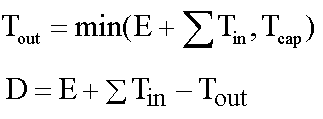D-Infinity Transport Limited Accumulation¶
Description¶
This function is designed to calculate the transport and deposition of a substance (e.g. sediment) that may be limited by both supply and the capacity of the flow field to transport it. This function accumulates substance flux (e.g. sediment transport) subject to the rule that transport out of any grid cell is the minimum between supply and transport capacity, Tcap. The total supply at a grid cell is calculated as the sum of the transport in from upslope grid cells, Tin, plus the local supply contribution, E (e.g. erosion). This function also outputs deposition, D, calculated as total supply minus actual transport.

Here E is the supply. Tout at each grid cell becomes Tin for downslope grid cells and is reported as Transport limited accumulation (tla). D is deposition (tdep). The function provides the option to evaluate concentration of a compound (contaminant) adhered to the transported substance. This is evaluated as follows:

Where Lin is the total incoming compound loading and Cin and Tin refer to the Concentration and Transport entering from each upslope grid cell.

If

else

where Cs is the concentration supplied locally and the difference in the second term on the right represents the additional supply from the local grid cell. Then,

Cout at each grid cell comprises is the concentration grid output from this function.
If the outlets shapefile is used the tool only evaluates that part of the domain that contributes flow to the locations given by the shapefile.
Transport limited accumulation is useful for modeling erosion and sediment delivery, including the spatial dependence of sediment delivery ratio and contaminant that adheres to sediment.
Parameters¶
- D-Infinity Flow Direction Grid [raster]
- A grid giving flow direction by the D-infinity method. Flow direction is measured in radians, counter clockwise from east. This can be created by the tool “D-Infinity Flow Directions”.
- Supply Grid [raster]
- A grid giving the supply (loading) of material to a transport limited accumulation function. In the application to erosion, this grid would give the erosion detachment, or sediment supplied at each grid cell.
- Transport Capacity Grid [raster]
- A grid giving the transport capacity at each grid cell for the transport limited accumulation function. In the application to erosion this grid woul give the transport capacity of the carrying flow.
- Outlets Shapefile [vector: point]
Optional.
This optional input is a point shapefile defining outlets of interest. If this file is used, the tool will only evaluate the area upslope of these outlets.
- Check for edge contamination [boolean]
This option determines whether the tool should check for edge contamination. Edge contamination is defined as the possibility that a value may be underestimated due to grid cells outside of the domain not being considered when determining the result.
Default: True
Outputs¶
- Transport Limited Accumulation Grid [raster]
- This grid is the weighted accumulation of supply accumulated respecting the limitations in transport capacity and reports the transport rate calculated by accumulating the substance flux subject to the rule that the transport out of any grid cell is the minimum of the total supply (local supply plus transport in) to that grid cell and the transport capacity.
- Deposition Grid [raster]
- A grid giving the deposition resulting from the transport limited accumulation. This is the residual from the transport in to each grid cell minus the transport capacity out of the grid cell. The deposition grid is calculated as the transport in + the local supply - the tranport out.
Console usage¶
processing.runalg('taudem:dinfinitytransportlimitedaccumulation', dinf_flow_dir_grid, supply_grid, capacity_grid, outlets_shape, edge_contam, transp_lim_accum_grid, deposition_grid)